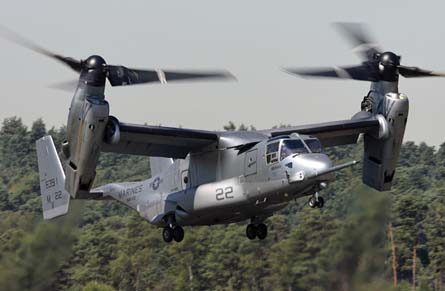The Bell Boeing joint venture will bring the MV-22 Osprey tilt-rotor to the Dubai air show for the first time, as it continues to push for the type's first export sale.
Saudi Arabia has been named by programme officials previously as one of 10 to 15 possible foreign buyers of the MV-22. In the last five years, Saudi officials have come close to acquiring transport and combat search and rescue helicopters from both France and Russia, but in each instance a deal was never closed.
 |
|---|
© AirTeamImages.com The type has seen off many of its critics after performing admirably on deployment in Iraq, Afghanistan and Libya |
Bell Boeing may be hoping to fill part of the Saudi military's rotorcraft gap with the MV-22, which can take off and land vertically and fly as fast as some fixed-wing turboprops.
If there are other possible buyers in the region, the programme has not identified them. But the joint venture manufacturing the Osprey is clearly pleased to bring the MV-22 to the region's largest showcase for aerospace products. "The Dubai air show is one of the world's fastest-growing aerospace events, and it presents an excellent opportunity for Bell Boeing to showcase the tilt-rotor Osprey's one-of-a-kind capability, unique value proposition and outstanding record of operational performance with a new audience," the company says. The MV-22 will join the Xian MA-600 regional airliner and the United Arab Emirates-based Quest helicopter among the aircraft making a debut at the show.
Bell Boeing and the US Naval Air Systems Command (NAVAIR), which acquires the MV-22 on behalf of the US Marine Corps, has been trying to attract foreign buyers since 2006. Two MV-22s flew across the Atlantic in July 2006 to make a debut appearance at the Farnborough air show in the UK, which has also been named a potential buyer.
AGGRESSIVE MARKETING
Earlier this year, the marines attended the Canadian International Air Show with the MV-22, as Ottawa also looks to its needs. But so far foreign sales have not materialised. For the MV-22 programme, closing an export deal within the next two years is more essential than ever. US government and company officials have been aggressively marketing the aircraft abroad for at least five years.
Finding foreign buyers is more important now than ever for the MV-22 programme to meet production targets. NAVAIR and Bell Boeing are currently negotiating a five-year procurement deal starting in fiscal year 2013 for 122 aircraft. Such multi-year deals normally require the contractor to offer a 10% price reduction, compared with the placement of a series of annual purchases. But ongoing budget reviews are threatening to slash between six and 24 aircraft from the total, however, Marine officials believe Bell Boeing can still meet the cost reduction targets with a reduction of even 24 aircraft - but they are also concerned that further MV-22 cuts are still possible. As the numbers drop, Bell Boeing will be challenged to meet the cost reduction targets required to get approval for the multi-year contract.
One possible solution to the production cuts problem is a wave of foreign purchases. The export market for the MV-22 has been slow to unfold, as the USMC has spent the past five years answering several questions about the value of the tilt-rotor aircraft.
In combat deployments to Iraq, Afghanistan and Libya since 2006, the MV-22 has proven wrong many of its critics. It has compiled the best safety record of any rotorocraft operated by the navy and marines. There have been no reports of the aircraft entering vortex ring state - the aerodynamic problem that caused the programme's deadliest crash during development testing in 2000. Moreover, the tilt-rotor's unique combination of speed and vertical landing ability has also proven critical in several operations. These included the rescue of a downed US Air Force Boeing F-15E Strike Eagle crewmember in Libya in late March.
Questions about the aircraft's safety have largely shifted to its cost and the maturing of the Bell Boeing supply chain. But the programme has achieved dramatic progress in these areas within the last nine months, according to the USMC.
Source: Flight International
















